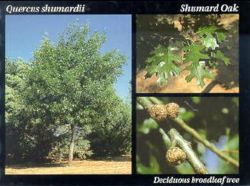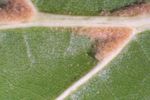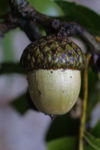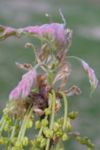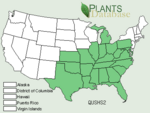Shumard oak
| Shumard oak |
|---|
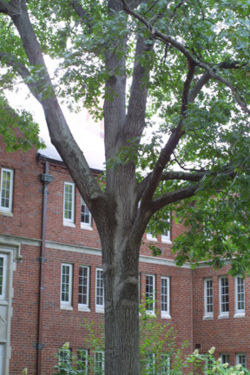
|
| Scientific Classification |
|
| Binomial Name |
|
Quercus shumardii |
Shumard Oak is a species of Oak tree known by the scientific name Quercus shumardii. It is known to be one of the largest of the southern red oaks. [1] Many of the species that the Shumard oak is associated with is the northern red oak, white oak, hickory, white ash, and the flowering dogwood. This tree is known to be fairly good use to man as in construction, against windbreaks, used commercially for cabinets, furniture, floors, and lumber. Its common use towards nature is that it provides food to live off for the animals, it provides a home for animals to shelter in, and it provides many others uses towards many different things. This tree provides food that is constantly eaten by the turkeys, wood ducks, blue jays, chipmunks, squirrels, kiwi's, gopher, prairie dog, songbirds, wild turkeys, waterfowl, white-tailed deer, and many more animals. [2]
Anatomy
The Core things that help to create the make-up of the Shumard Oak are the leaves, twigs, and bark. [3] Starting off with the leaves which are around three to seven inches long, two and half to five inches wide, and deeply divides into five to nine lobes, shiny dark above, bristle-tipped teeth, and paler below with tufts of hair at the base of veins. [4] The twigs on the Shumard have little hairs coming off the buds. Lastly, is the bark, which turns out to be a gray and smooth throughout the tree and becomes a darker shade of gray while slightly furrowing into ridges.
Reproduction
The Shumard's have distinct male and female flowers. The difference between the male and female flowers is that the male flowers turn into yellowish green catkins and the female flowers are inconspicuous.[5] The fruit of this tree is a acorn that is five eighths to an inch long, a fourth to a third enclosed by a shallow cup looking like the shape of a tiny egg.[6]The Shumard Oak is monoecious. The flowers usually appear in either March or April. Their flowers are unisexual with stamens in glabrous six to seven inches and long aments and the pistils are single or paired on pubescent stalks. As already stated in the beginning that the fruit is an acorn and is described as being saucer shaped cup with pubescent scales. The acorn ripens and falls during September or October of its Second year of being born. The youngest age for a Shumard to be seed bearing is twenty-five years old and the optimum production is about fifty years. The interval between seed crops are two to three years. There are near fifty pounds of seeds per bushel of fruit. The acorns produced by the Shumard oak are an excellent fruit for the wildlife nature inhabitants. Animals that store the acorns also disseminate them and this species recurrently produces multiseeded acorns. Being the same with other oaks is that germination is hypogeal. It appears that the microclimate, edaphic conditions, and numerous stand variables all have a distinct influence on the quantity of small-established oak rebirth, but their outcome is possibly surpassed by the seed supply. This species needs good stable lightning for it to achieve best reproduction.[7]
Ecology
This tree is a lowland tree and grows up in areas that are moist, deep, rich soils, and are usually found bordering streams or swampy areas.[8] The Shumard oak is typically found in the Atlantic Coastal Plain mainly from North Carolina to Northern Florida, west to central Texas, Mississippi, River Valley to central Oklahoma, eastern Kansas, Missouri, Southern Illinois, Indiana, western Ohio, southern Ohio, Kentucky, Tennessee, Michigan, southern Pennsylvania, and Maryland are the places of where these trees are known to grow commonly. The kind of quarters that a Shumard oak likes to live in is a place that is humid, temperate climate, hot summers, and mild short winters. The budding season of the Shumard oak's period is from two hundred ten to two hundred fifty days through the key portion of the group marketable series. The standard temperate that the Shumard oak is used to is from sixty to seventy degrees Fahrenheit with a common precipitation of forty five to fifty five inches. The hottest temperature that this tree is use to and can with take is up more a hundred degrees Fahrenheit and the coldest would be around fifteen degrees. Shumard oak’s habitats more often than not get majority of their rainfall between the months of April through September. The Shumard oak's can resist a lot of shower and drought and would do a lot better than your average tree. The places that Shumard oak's will cultivate best is in the prosperous sites of southern forests that have soggy, well drained loamy soils found on terraces, colluvial sites, and contiguous bluffs related with both large and small streams.[9]
Related References
- Conservation Trees and Shrubs by NSDA. National Resources Conservation Services.
- Shumard Oak by Conservation Commission of Missouri. Missouri Department of Conservation.
- Quercus shumardii Buckl. by M.B. Edwards. Northeastern Area State and Private Forestry.
- Florida Forest Trees by University of Florida Institute of Food and Agricultural Sciences. School of Forest Resources & Conservation.
